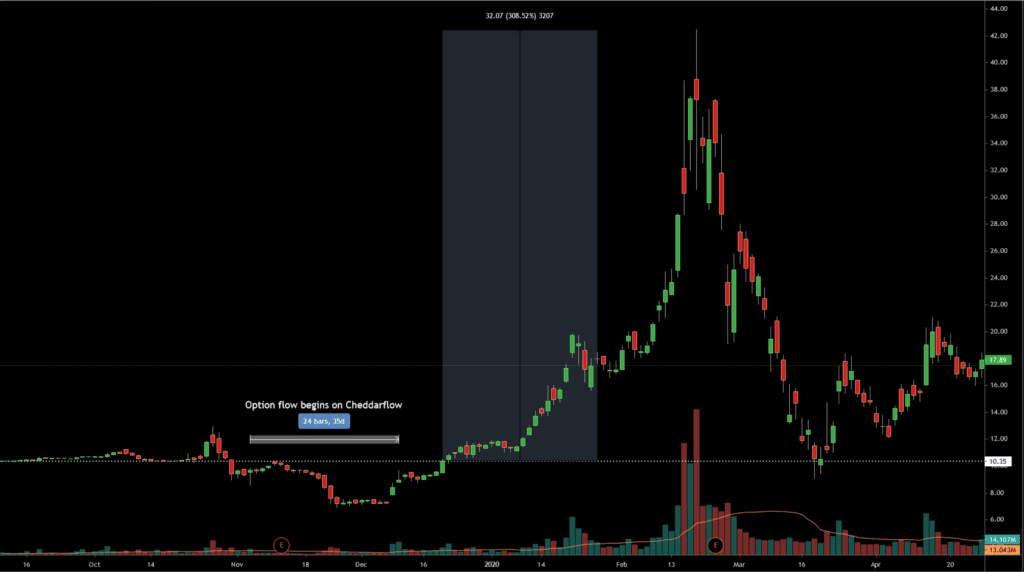A very popular strategy used by value investors is purchasing leap option contracts. Generally, options are a powerful tool for both building capital and hedging existing plays. Some traders use complex spreads to collect premium and others are simply buying weekly options to trade short term volatility. Both of these provide great ability to produce profits. What is often left out of the hype are long term dated options, often called leaps.
Introduction to leap options
A leap option is an option contract typically with a date more than a year out, typically out of the money (above strike price).
Starting with the basics of what an option premium is, there’s a few things that go into this equation, namely theta, delta, and distance from the strike price. If you need a quick refresher, please read this article on the greeks.
When browsing a standard option chain, you will find options with strikes going out as far as two years, but shy away from the premiums for these options, as they usually are more expensive.
Let’s say you have a dynamite investment thesis on a company and think it’s dramatically undervalued. Should you get some exposure?
A couple of things to keep in mind. Time is the risk profile killer and buying more of it costs extra. On the other hand, time can also act as a premium booster if you’ve positioned yourself correctly with the trade.
Trading Virgin Galactic Holdings
I’d like to use an example for a trade I took back in November. While the new cult stock for Virgin Galactic (SPCE) was bleeding out, I observed on Cheddar Flow the deeper it went, bullish leap contracts were being bought up.

Within weeks it went on a historic push to the upside and the options that were purchased netted a significant profit. Because there was still a good amount of time left on the contract, “time decay” was very low.
Thankfully, I did not hold onto these through the Covid-19 market volatility. With such a dated expiration, selling it near the top meant I could off load it onto another investor who thought continuation was coming at a nice premium.
Could I have done shorter term options and profited more? Yes. Absolutely. Would it have required more precision and timing? Yes. This shorter term approach is a risk for true investors who don’t know how to trade technicals but love a stock fundamentally and want to invest over a longer time horizon.
You could have approached this the same way on indexes or any other stock by buying 2021 or 2022 calls for near the corona bottom.
Why not just buy the stock?
100 shares of most assets is going to be a large investment for the typical retail trader. Purchasing options allows you to buy into your thesis on a stock at a fraction of the cost. Your maximum risk is fixed with options, particularly with calls you have unlimited upside potential and can only lose the premium you put in.
If you buy 100 shares of an asset at a market top, you could lose 50% of that position if the stock does poorly and you didn’t set a stop loss. Sometimes a stop loss can’t even save you as we saw with Luckin Coffee (LK) this year which went from $24 to $2 overnight. While this is less likely to happen with strong solid companies, it’s a risk to be aware of with any spot holdings.
Fixed risk is the benefit here and it is why the leap option strategy is so valuable if done correctly.
Rolling strategy
Most options only let you buy two years out or less, depending on the stock or index. SPY, for example, only has options dating to late 2022 at this moment. This means your investment premise needs to be right within a very fixed window of time.
This can be something that might scare away some long term investors who simply want to buy and hold for a decade. This can be mitigated by “rolling” the option into fresh leaps as your expiration approaches.
Rolling just means you close the option contract and purchase new ones with a further out expiration. This would of course sacrifice your low entry that you got months/years prior. Also, once you’re in the money and your idea has clearly played out, you can also exercise the calls and enjoy your new found wealth via share holding.
Downsides to leap contracts
Dividends: Derivatives don’t collect dividends. If you’re only buying the equivalent exposure of $10,000 on a stock that yields 1% annually that’s probably not a large issue for dividend fans. But it is a detractor from simply holding spot shares. If you are a larger investor, then those dividends can add up over a multi year period.
Inability to sell premium: Long term believers in a stock may write options near short term peaks or bottoms to generate income. You can’t write a derivative of a derivative, so if you’re managing a large position and actively hedging for upside and downside you cannot cover this base using leap options. You can however buy shorter term options in the opposite direction as a hedge in case of a black swan event for the asset in question.
Final thoughts
This should give you a primer on the value of leap options. They may not yield as much as some of those attractive weekly options during volatility but they give you the cushion of time to let your idea play out.
They also free up more of your capital to invest into other assets via options or spot holdings. Keep an eye on your theta (premium) decay once the asset is approaching ¾ completion because it will start to eat into your profits unless the asset keeps going up.




